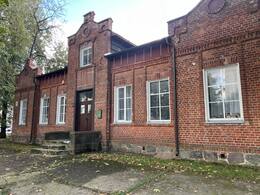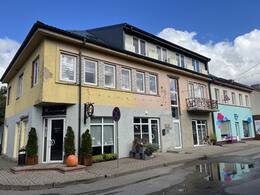Life at the headquarters of the stribes
It tells the story of the post-war situation in the Lithuanian countryside and the decision to become a partisan.
Our father Jonas Mikutavičius (born 1901) was a farmer and volunteer. We grew up with two daughters in Basonių village, near Kalviai. The elder Onutė (born 1924) and I, Bronė (born 1929), were raised in the spirit of love for the Motherland, so after the war, when the resistance began, we became partisan liaisons. They were acquaintances of the Praškevičiai family, whose three children went to the forest. One of them, Antanas-Narsuolis, received information from us about the partisan movement. After all, our homestead was near the Kalviai stribynas, which was a manor house, and the notorious traitors Vareikas father and son lived nearby. So we had to be very careful. There was a bunker in the house, so partisans often hid there or treated their wounded there. On the one hand, it was a big risk, but the thugs didn't even think that our men were coming to change clothes, eat, and wash up, hiding right there, next to them.
Our whole family helped the partisans. I maintained contact between the Narsuolis and Žaibas detachments. The Žaibas detachment included Albinas Ašmena-Siaubas, Vytautas Bliujus-Serbentas, the Seliutos brothers, Stasys Jackevičius-Genys, Stepas Stankevičius-Šermukšnis, Bronius Daugsevičius-Meška, Zigmas Kacevičius, Ignas Nasutavičius from Semeliškės, as well as men from the villages of Vindziuliai, Mičiūnai, Šoliškės, Beižonys, and others. The Albinas Bliujus-Don Kichotos detachment operated between Semeliškės and Kaukinė.
In 1947, my father Jonas was imprisoned in Abezė until 1954. My mother Stefanija (born 1900) and I were deported to the Usolė district, Žilkino village, Irkutsk region, in 1949. There I met my future husband, the partisan Stepas Kveraga. In exile, we had two sons, and my father fell ill. Stepas returned to Lithuania with our sick father in 1957, but he was arrested again in Kaišiadorys and taken to the Irkutsk region. We were there until 1962. By then we had raised three children. We settled in Elektrėnai.
The children were our greatest joy. They grew up knowing everything about the occupation of Lithuania, encouraged by respect and love for their country. And when our eighth-grade son Liudvikas distributed his written leaflets in Elektrėnai "Down with Soviet rule", "Long live free Lithuania", and was expelled from school, Stepas only told him: "You handsome man!" Now that Stepas is no longer with us, I am proud of his life, the children's, and my own. Our suffering was meaningful.
- Stanislovas Abromavičius, Kęstutis Kasparas, Ruta Trimonienė, Partisans of the Great Fighting District, Kaunas, 2007.
Related objects
NKVD - MVDV-MGB Kretinga County Building
During the second Soviet occupation, Soviet occupation structures were established in many Lithuanian towns. During the Nazi occupation, the former residence of the interwar Lithuanian doctor and prominent public figure Feliksas Janušis housed the headquarters of the Nazi German Gestapo, and during the second Soviet occupation, the Kretinga department of the NKVD-MVD-MGB was located in this building. Lithuanian citizens and participants in the anti-Soviet resistance were interrogated and tortured there.
In the 1910s, thanks to the care of the Kretinga district municipality administration and the owner of the house, the pastor of the Kretinga Evangelical Lutheran parish, Darius Petkūnas, a memorial plaque was unveiled on the wall of the building in memory of the people interrogated and tortured in this building in 1944–1953.
NKVD-MVDV-MGB-KGB Kretinga Subdistrict Headquarters with Arrest Ward
Built in 1935, the house housed an apartment, a hotel and a restaurant, but in 1940 the house was nationalized. In 1944 it was transferred to the Kretinga County Subdistrict of the NKVD, and from 1953 it became the headquarters of the Kretinga County Subdistricts of the KGB and the militia with a detention center. In the post-war years, lists of Kretinga County residents selected for deportation to the depths of Russia were compiled in this building, and fighters for Lithuanian freedom and their contacts and supporters were imprisoned, interrogated and tortured. During the torture, the NKVD officers would start the car engine so that the noise it emitted would drown out the screams of the tortured people. In the post-war years, the people of Kretinga nicknamed this building the “Fur Workshop”. The bodies of killed partisans brought from the Kretinga area were dumped near the building and in its yard.






